597 Search Results for tell me about it
March 26, 2018
by Carole Zangari -
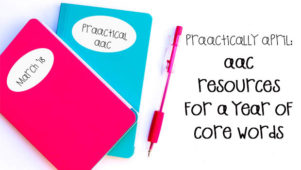
It’s almost time to turn the calendar to a new page and that gives us the opportunity to highlight a new set of core words. Whether you are following along with the Set 1 (12 words/month) or the Set 2 words (16 words/month; Different than the previous core words), or are just getting started, this post has some helpful resources. We’re grateful to Nancy Inman, Brian Whitmer, Tina Lombardi, Barbara Fernandes, Russell Cross, Gail Van Tatenhove, Allison Wade, Eric Sailers, Bill and Lori Binko, Heidi LoStracco, Rachael Langley, and all the others who have contributed to this effort. Our words for this month are as follows. Set 1 List: big, busy, do, drink, feel, he, in, make, out, some, tell, who Set 2 List: blue, brother, close, family, head, last, long, no, old, right, scared, soft, thing, top, wash, whole Here are some resources to help with implementation. Templates for you to plug... [Read More...]
February 22, 2018
by Carole Zangari -
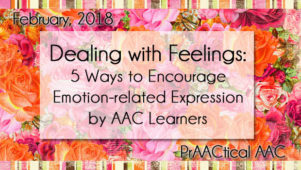
Words for emotions and feelings are pretty common in AAC devices and non-electronic communication aids, like PODD books and eye gaze boards. It’s wonderful when our clients can tell us they are sad or angry with words rather than using challenging behaviors or suffering in silence. What can we do to further their skills in this area? Here are some suggestions to get us thinking. Beyond the Basics: Consider going beyond the basic feeling words (i.e., happy, sad, mad, tired, scared) and including additional emotion words in the AAC system (e.g., frustrated, embarrassed, disappointed, lonely, worried). Don’t assume that this is inappropriate just because an individual has lower language levels or cognitive delays. To learn language, we have to have access to it. Model, model, model: Use these emotion words throughout the day to express your own feelings, and narrate your observations of how others are feeling (e.g., “Joey’s crying... [Read More...]
January 18, 2018
by Carole Zangari -
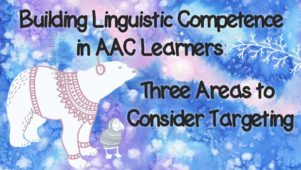
For several years, those who specialize in supporting AAC learners have stressed the need to develop AAC systems and programming that go beyond the communicative function of requesting in order to target the ability to protest, reject, comment, etc. This has been an important trend that will empower users of AAC to express themselves in much fuller ways. What other things should we be targeting in order to help our clients and students become more linguistically competent? Here are some ideas for goal areas to consider. Temporal Markers: While no one can overstate the importance of talking about our current needs, interests, observations, and preferences, we have to be careful not to get stuck in the moment. It is also important for our AAC learners to develop the language skills to be able to talk about things that already happened or that will/might be happening. Why? Among other things, this... [Read More...]
January 16, 2018
by Carole Zangari -
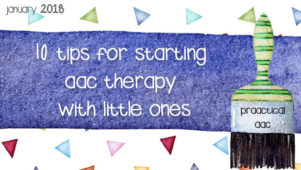
It’s exciting to see so many graduate student SLPs and new graduates who are interested in working with people with AAC needs. We hear from them frequently with questions about how to be effective in their therapy and the practical aspects of running a good therapy session. Here are some tips we frequently share with those who are starting to implement AAC with young children. Use a visual schedule for every session. The operative word there is ‘use.’ Making a schedule for our therapy is a great start, but unless we really use the schedule all throughout the session, it’s unlikely to provide many benefits. Go to it as soon as you get into the room, AND before and after every activity. (For those who are interested, there is more on making and effectively implementing visual schedules here. Trust the process. You will need to do this at least 4-8... [Read More...]
December 31, 2017
by Carole Zangari -
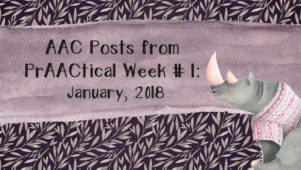
Ready to launch a brand new year? Let’s make it full of AAC goodness! In the meantime, here are a few posts from last week to catch up with. Monday: Happy Christmas! Wednesday: Top AAC Videos Thursday: PrAACtically January: AAC Resources for A Year of Core Words Looking for more to browse? Check out these previous posts for a little AAC inspiration. Teaching Peers About AAC A Classroom Journey with PODD Writing to Read It’s All About Us Magic Moments with Tellagami
December 4, 2017
by Carole Zangari -
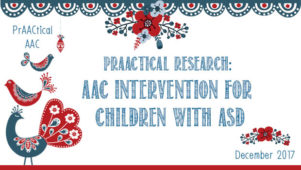
Dr. Kathy Howery is back with another helpful post an AAC research. Kathy is based in Alberta, Canada, and has worked in the field of AT and special education for over three decades. In the past year, she completed her doctoral studies where she used phenomenological methods to seek to understand the lived experience of speaking with/through a speech generating device. Kathy is currently working as a consultant to schools and school districts across Alberta focusing primarily on children and youth with complex communication needs. In this article, she discusses research on AAC interventions. Enjoy! ::::::::::::::::::::::::::::::::::::::::::::::::::::::::::::::::::::::::::::::::::::::::::::: Almirall, D. , DiStefano, C., Chang, Y.-C., Shire, S., Kaiser, A., Lu X, Nahum-Shani, I., Landa, R., Mathy, P. & Kasari, C. (2016). Longitudinal Effects of Adaptive Interventions with a Speech-Generating Device in Minimally Verbal Children with ASD. Journal of Clinical Child & Adolescent Psychology, 45(4), 442-456. What this article is all about (the focus... [Read More...]
December 3, 2017
by Carole Zangari -
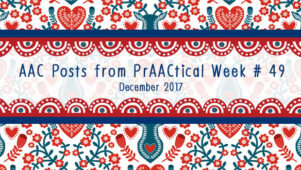
Hello, December! Life seems to be speeding up these days, with little time for reading blog posts. Here are a few that you may have missed. Monday – PrAACtically December: AAC Resources for A Year of Core Vocabulary Wednesday – Video of the Week: CVI – The Everyday Impact on People Who Use AAC Thursday – PrAACtically Reading with Karen Natoci: Hello, Holidays! Shopping, wrapping, baking, decorating…all part of the holiday preparations. But, as AAC interventionists, we’re also thinking about preparations of a different sort – helping our AAC learners get ready for the holidays. Holidays can be tough, not just because of the change in routine, but also because there are so many expectations for conversation. Here are some past posts related to conversational skills. Balance Pans: A Learning Toy that Helps Build Conversation Skills From Conversation to Skill-Building Conversations with Adults who have Intellectual Disabilities AAC Conversation Club Holiday Talk: AAC... [Read More...]
November 20, 2017
by Carole Zangari -
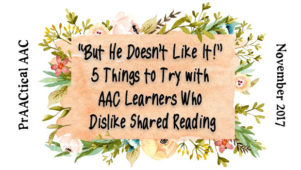
Have you had an experience like Stacy’s? Stacy SLP knows the importance of building literacy skills in her students who use AAC and was happy to have found an age respectful book that aligns with the curriculum. She downloaded it onto her iPad and practiced reading it so that the push-in session would go smoothly. Stacy reviewed the students’ SGDs and came up with a plan for targeting specific language or AAC skills. She was determined to infuse more literacy activities into her therapy and began the reading activity with equal measures of excitement and nervousness. It was both frustrating and disheartening when her students didn’t like the activity, were hard to engage, and even tried to escape. Within the first few minutes, her enthusiasm had turned to fear (’What do I do NOW?’) and dread (‘How am I going to get through this session?!’). Many of us have had... [Read More...]
November 12, 2017
by Carole Zangari -
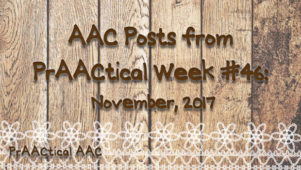
It’s a beautiful day to grab a mug of coffee or pour a cup of tea, and head for a comfy spot to catch up on some AAC reading. Monday – AAC Site of the Month: Centre for AAC (CAAC) Wednesday – Video of the Week: Analyzing the Communication Environment Thursday – PrAACtical Information: 5 AAC Presentation Handouts :::::::::::::::::::::::::::::::::::::::::::::::::::::::::::::::::::::::::::::::::::::::::: Need a few more suggestions? Here are a handful past post on AAC and young children. Preschool AAC and Visual Supports from Orange County Public Schools TELL ME – AAC in the Preschool Classroom Supporting Preschoolers with AAC Needs-A Case Study Visual Supports in Action: The Preschool Classroom Mining Preschool Routines for PrAACtical AAC Opportunities Have a great week, AAC friends!
October 26, 2017
by Carole Zangari -
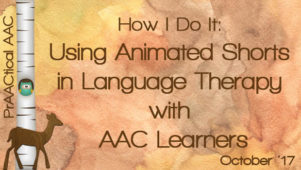
Looking for ways to engage AAC learners in language therapy? Today, we welcome back SLP Rachel Madel to tell us about her experience in using wordless videos. Her prAACtical tips will get you excited about using videos like these, curated by The Activity Tailor, in your lessons. Enjoy! ::::::::::::::::::::::::::::::::::::::::::::::::::::::::::::::::::::::::::::::: Using Animated Shorts to Build Language Skills with AAC Learners We are living in a digital age, where video content is often free and easy to access. Children on my caseload are tech savvy and are constantly dazzling me with how well they can navigate YouTube to find their favorite videos. Motivation is paramount in creating meaningful communication interactions and watching animated videos is highly motivating for both students and clinicians. I’ve had great success utilizing wordless videos in my practice and was lucky enough to present on the topic during “AAC After Work” with a fellow AAC colleague, Susan Berkowitz. In case... [Read More...]









